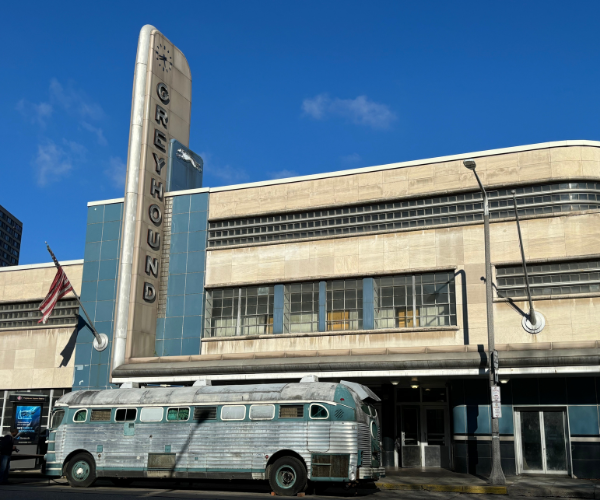Andrea Chevalier steps back and takes in the scene: steelworkers bending over red-hot pails of molten metal, construction crews unveiling blueprints and a mother clutching an infant in her arms. The Terminal Tower rises behind them all.
“When we first took it down, it had graffiti on it, and it was very dirty,” Chevalier recalls.
She helped rescue this and another mural from Tremont’s Valleyview Homes Estate before it was torn down in 2005. Today, inside a renovated glass tile factory in Ohio City, Chevalier, senior painting conservator with the Intermuseum Conservation Association, is restoring the works, one brush stroke at a time.
The government’s Works Project Administration commissioned artist Elmer Brown to create the murals during the Depression. The city was a regional administrative center for federal art projects at the time, and Cleveland artists were hired to create murals in many public buildings.
But Brown’s 1941 works became a victim of neglect. Even after Tremont was reinvented as a destination neighborhood in the 1990s, Valleyview lagged behind.
“The children’s play area was overgrown with weeds. There was litter everywhere and graffiti on the buildings,” recalls Tremont West Development Corp. executive director Chris Garland.
In 2004, the Cleveland Metropolitan Housing Authority received federal funding to build 189 units of new, mixed-income housing on the Valleyview site, which stirred interest in saving the WPA art housed there.
The Intermuseum Conservation Association took on the painstaking process of removing Brown’s murals. “First we used sharpened spatulas to loosen the mural from the walls,” Chevalier says. The removal process took several weeks, and it was only the beginning.
Once Brown’s murals were mounted on nonwoven polyester and hung on the wall, Chevalier began to secure loose paint. She then filled in missing sections by mixing colors and trying to match them to the originals.
“Sometimes we don’t even have old photos,” she says. “If we don’t have much information, we try to interpret the artist’s intentions.”
Chevalier even painstakingly restored an image of the Terminal Tower that had been lost from the piece for decades. When Brown installed his murals at Valleyview in 1941, a ceiling beam blocked the portion depicting the building, so he cut it out. Chevalier worked from sketches and photos of the original piece to restore it to the mural.
The restored Brown murals will become a centerpiece of Cleveland State University’s new student center, which is scheduled to be completed next spring.
Lauren Hansgen, interim director of the Cleveland Artists Foundation, says Brown’s work is significant because it shows the power of public art to inspire people.
“These murals depict ordinary people who were building America,” she says. “They say to the viewer, ‘Remember this aspect of our past? We can do this again,’ and that’s powerful.”
“When we first took it down, it had graffiti on it, and it was very dirty,” Chevalier recalls.
She helped rescue this and another mural from Tremont’s Valleyview Homes Estate before it was torn down in 2005. Today, inside a renovated glass tile factory in Ohio City, Chevalier, senior painting conservator with the Intermuseum Conservation Association, is restoring the works, one brush stroke at a time.
The government’s Works Project Administration commissioned artist Elmer Brown to create the murals during the Depression. The city was a regional administrative center for federal art projects at the time, and Cleveland artists were hired to create murals in many public buildings.
But Brown’s 1941 works became a victim of neglect. Even after Tremont was reinvented as a destination neighborhood in the 1990s, Valleyview lagged behind.
“The children’s play area was overgrown with weeds. There was litter everywhere and graffiti on the buildings,” recalls Tremont West Development Corp. executive director Chris Garland.
In 2004, the Cleveland Metropolitan Housing Authority received federal funding to build 189 units of new, mixed-income housing on the Valleyview site, which stirred interest in saving the WPA art housed there.
The Intermuseum Conservation Association took on the painstaking process of removing Brown’s murals. “First we used sharpened spatulas to loosen the mural from the walls,” Chevalier says. The removal process took several weeks, and it was only the beginning.
Once Brown’s murals were mounted on nonwoven polyester and hung on the wall, Chevalier began to secure loose paint. She then filled in missing sections by mixing colors and trying to match them to the originals.
“Sometimes we don’t even have old photos,” she says. “If we don’t have much information, we try to interpret the artist’s intentions.”
Chevalier even painstakingly restored an image of the Terminal Tower that had been lost from the piece for decades. When Brown installed his murals at Valleyview in 1941, a ceiling beam blocked the portion depicting the building, so he cut it out. Chevalier worked from sketches and photos of the original piece to restore it to the mural.
The restored Brown murals will become a centerpiece of Cleveland State University’s new student center, which is scheduled to be completed next spring.
Lauren Hansgen, interim director of the Cleveland Artists Foundation, says Brown’s work is significant because it shows the power of public art to inspire people.
“These murals depict ordinary people who were building America,” she says. “They say to the viewer, ‘Remember this aspect of our past? We can do this again,’ and that’s powerful.”



